Failure to meet the reession head-on put homebuilder Ryland Group Inc. in a deeper hole than its competitors, and now the company is trying another strategy – one analysts say should help the company improve its performance. As the economy soured, Calabasas-based Ryland hunkered down by growing its cash reserves. It didn’t buy land for new communities. It didn’t cut costs. That was how Ryland’s former Chief Executive and President Chad Dreier dealt with the dismal housing market before he retired almost two years ago. Ryland’s current CEO and President Larry T. Nicholson is trying to reverse his predecessor’s conservative approach, analysts say. But the company is still fighting its past and the housing market remains weak. “He (Nicholson) realized he needed to play offense instead of defense,” said Stephen East, an analyst with Ticonderoga Securities who follows Ryland Group. Nicholson has been more “aggressive” than his predecessor in terms of land purchases the past nine to 12 months, he added. Market observers are forecasting a better year for the company this year, despite the company’s first-quarter earnings, released April 27, which fell short of analysts’ expectations. Nicholson declined to be interviewed. Attempts to reach another representative of Ryland were not successful. Ryland reported a net loss of $19.5 million, or $0.44 per diluted share, on revenues of $174.9 million for the quarter ending March 31. The company reported a net loss of $14.3 million, or $0.33 per diluted share, on revenues of $250.8 million for the same period last year. The company’s new home orders slid 17 percent in the quarter, while its home closings, a key part of revenue, fell 30 percent. In the same period, competitors D.R. Horton Inc. had net income of $27.8 million on revenues of $733.1 million, and Pulte Homes had a net loss of $39.5 million on revenues of $805.2 million. KB Homes reported a net loss of $114.5 million on revenues of $196.9 million for the first quarter ended Feb. 28. Ryland’s results missed analysts’ consensus forecast for a loss of $0.31 a share on $186.5 million in revenue. Joel Locker, with FBN Securities in San Diego, said he and other analysts expected better results because the company built more new communities in the first three months of 2011, compared to a year ago. Ryland built 11 new communities in the first quarter and added 41 communities since March 31, 2010. Nicholson identified building new communities as the most important part of the company’s growth and profitability plan when he spoke in early March to institutional investors at a conference sponsored by financial services firm Raymond James Financial Inc. “We would expect to end the year at about 245 communities, so we will have continued growth through this year,which sets the platform for the growth,” Nicholson said. The strategy of adding new communities should raise Ryland’s gross margins amid higher demand and lead to positive modest earnings, said Ken Zener, an analyst with Keybanc Capital Markets. Low gross margins, the amount Ryland keeps after the total cost for housing sales is subtracted from total housing revenues, is the company’s main weakness, Zener said. In the first quarter, the company had gross margins of 13.2 percent compared to the 12.2 percent in the first quarter of 2010. One advantage Ryland has over its competitors in this difficult housing market is that it’s not saddled with excess land that it has been unable to sell or build on for years, Zener said. Ryland has a four-year supply of land on which to build homes, which is less than the 5 ½ year supply of competing homebuilders, he said. “They can buy new land that, in theory, is priced better,” Zener said. Another move by Nicholson that, analysts say, will help Ryland’s bottom line was a company reorganization that started late last year and continued through early January. Nicholson consolidated homebuilding regions, resulting in layoffs and an estimated annual company savings of $8 million, according to company figures. Those cuts eliminated multiple layers of management and reduced spending at the headquarters and regionally, East said. “We’re totally comfortable with the group that we have left in our homebuilding group that are very talented folks that will be able to respond to any turn in the market,” Nicholson said, in an earnings conference call in January. The obvious challenge that Ryland and other new homebuilders share is a soft market in which existing homes are the main competition, particularly when it comes to cost. Locker, of FBN Securities, said homebuilders will need to offer a better product at a competitive price with better warranties and energy efficiency options. Homebuilders have an edge over those selling existing homes in that they can help with financing, he said. The growth rate for new homes will be flat in 2011, with a projected 15 percent increase for 2012 and 2013, Zener said. Still, modest housing demand will keep builders from earning significant amounts of profit.
